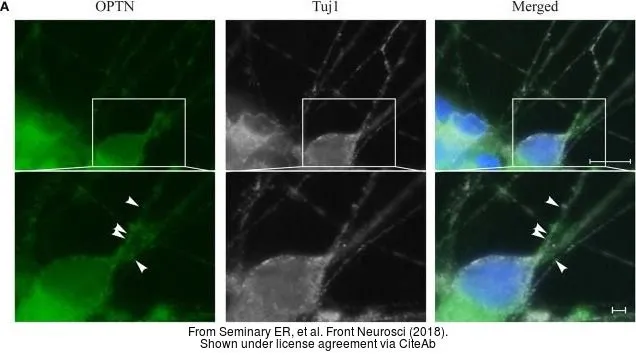beta Tubulin 3/ Tuj1 antibody [GT11710]
GTX631836
ApplicationsImmunoFluorescence, ImmunoPrecipitation, Western Blot, ImmunoCytoChemistry, ImmunoHistoChemistry, ImmunoHistoChemistry Frozen, ImmunoHistoChemistry Paraffin
Product group Antibodies
TargetTUBB3
Overview
- SupplierGeneTex
- Product Namebeta Tubulin 3/ Tuj1 antibody [GT11710]
- Delivery Days Customer9
- Application Supplier NoteWB: 1:500-1:20000. ICC/IF: 1:100-1:1000. IHC-P: 1:100-1:1000. IHC-Fr: 1:100-1:1000. IP: 1:100-1:500. *Optimal dilutions/concentrations should be determined by the researcher.Not tested in other applications.
- ApplicationsImmunoFluorescence, ImmunoPrecipitation, Western Blot, ImmunoCytoChemistry, ImmunoHistoChemistry, ImmunoHistoChemistry Frozen, ImmunoHistoChemistry Paraffin
- CertificationResearch Use Only
- ClonalityMonoclonal
- Clone IDGT11710
- Concentration1 mg/ml
- ConjugateUnconjugated
- Gene ID10381
- Target nameTUBB3
- Target descriptiontubulin beta 3 class III
- Target synonymsCDCBM, CDCBM1, CFEOM3, CFEOM3A, FEOM3, TUBB4, beta-4, tubulin beta-3 chain, class III beta-tubulin, tubulin beta-4 chain, tubulin beta-III, tubulin, beta 3
- HostMouse
- IsotypeIgG2b
- Protein IDQ13509
- Protein NameTubulin beta-3 chain
- Scientific DescriptionThis gene encodes a class III member of the beta tubulin protein family. Beta tubulins are one of two core protein families (alpha and beta tubulins) that heterodimerize and assemble to form microtubules. This protein is primarily expressed in neurons and may be involved in neurogenesis and axon guidance and maintenance. Mutations in this gene are the cause of congenital fibrosis of the extraocular muscles type 3. Alternate splicing results in multiple transcript variants. A pseudogene of this gene is found on chromosome 6. [provided by RefSeq]
- Storage Instruction-20°C or -80°C,2°C to 8°C
- UNSPSC12352203
References
- Intranasal administration of induced pluripotent stem cell-derived cortical neural stem cell-secretome as a treatment option for Alzheimers disease.Read more
- Distribution of macrophages in the developing cochlea of the common marmoset, a primate model animal.Read more
- Spinal cord tissue engineering using human primary neural progenitor cells and astrocytes.Read more
- Treatment with the Ferroptosis Inhibitor Ferrostatin-1 Attenuates Noise-Induced Hearing Loss by Suppressing Ferroptosis and Apoptosis.Read more
- Early development of the cochlea of the common marmoset, a non-human primate model. Hosoya M et al., 2022 May 7, Neural DevRead more
- Mitigating Effect of Estrogen in Alzheimers Disease-Mimicking Cerebral Organoid. Kim JY et al., 2022, Front NeurosciRead more
- A functional SNP rs895819 on pre-miR-27a is associated with bipolar disorder by targeting NCAM1. Yang Y et al., 2022 Apr 4, Commun BiolRead more
- mito-TEMPO Attenuates Oxidative Stress and Mitochondrial Dysfunction in Noise-Induced Hearing Loss via Maintaining TFAM-mtDNA Interaction and Mitochondrial Biogenesis. Chen JW et al., 2022, Front Cell NeurosciRead more
- Establishment of a human induced pluripotent stem cell neuronal model for identification of modulators of A53T alpha-synuclein levels and aggregation. Vajhoej C et al., 2021, PLoS OneRead more
- alpha-Synuclein antisense transcript SNCA-AS1 regulates synapses- and aging-related genes suggesting its implication in Parkinsons disease. Rey F et al., 2021 Dec, Aging CellRead more



![ICC/IF analysis of Neuro2a cells using GTX27751 beta Tubulin 3/ Tuj1 antibody [TU-20]. Green : Primary antibody Blue : DAPI Diultion : 3microg/ml](https://www.genetex.com/upload/website/prouct_img/normal/GTX27751/GTX27751_20191028_ICC-IF_1_w_23060722_961.webp)
![ICC/IF analysis of SH-SY-5Y cells using GTX11314 beta Tubulin 3/ Tuj1 antibody [SDL.3D10] at 1:400(pink) with DAPI(blue). Cells were fixed and permeabilized with methanol followed by methanol:acetone.](https://www.genetex.com/upload/website/prouct_img/normal/GTX11314/GTX11314_20170605_ICCIF_w_23060500_832.webp)
![FACS analysis of A549 cells using GTX83356 beta Tubulin 3/ Tuj1 antibody [2E9]. Green : beta Tubulin 3/ Tuj1 Purple : negative control](https://www.genetex.com/upload/website/prouct_img/normal/GTX83356/GTX83356_20170912_FACS_w_23061322_791.webp)
![WB analysis of various cell lines using GTX83460 beta Tubulin 3/ Tuj1 antibody [5H2]. Loading : 35 ug per lane](https://www.genetex.com/upload/website/prouct_img/normal/GTX83460/GTX83460_3597_WB_w_23061419_857.webp)
